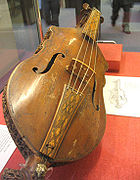
Citole
Encyclopedia

French language
French is a Romance language spoken as a first language in France, the Romandy region in Switzerland, Wallonia and Brussels in Belgium, Monaco, the regions of Quebec and Acadia in Canada, and by various communities elsewhere. Second-language speakers of French are distributed throughout many parts...
diminutive form of cithara, and not from Latin cista, a box), an archaic musical instrument
Musical instrument
A musical instrument is a device created or adapted for the purpose of making musical sounds. In principle, any object that produces sound can serve as a musical instrument—it is through purpose that the object becomes a musical instrument. The history of musical instruments dates back to the...
of which the exact form is uncertain. It is generally shown as a four-string instrument, with a body generally referred to as "holly-leaf" shaped. There is a surviving instrument from around 1300 from Warwick Castle
Warwick Castle
Warwick Castle is a medieval castle in Warwick, the county town of Warwickshire, England. It sits on a bend on the River Avon. The castle was built by William the Conqueror in 1068 within or adjacent to the Anglo-Saxon burh of Warwick. It was used as a fortification until the early 17th century,...
which is now in the British Museum, albeit at some point, probably in the sixteenth century, it was converted into a violin with tall bridge, 'f'-holes and angled fingerboard; thus the image below of the instrument's top is not representative of its original appearance.

Psaltery
A psaltery is a stringed musical instrument of the harp or the zither family. The psaltery of Ancient Greece dates from at least 2800 BC, when it was a harp-like instrument...
, and the Vulgate lyrae
Lyre
The lyre is a stringed musical instrument known for its use in Greek classical antiquity and later. The word comes from the Greek "λύρα" and the earliest reference to the word is the Mycenaean Greek ru-ra-ta-e, meaning "lyrists", written in Linear B syllabic script...
. It has been supposed to be another name for the psaltery
Psaltery
A psaltery is a stringed musical instrument of the harp or the zither family. The psaltery of Ancient Greece dates from at least 2800 BC, when it was a harp-like instrument...
, a box-shaped instrument often seen in the illuminated missals of the Middle Ages
Middle Ages
The Middle Ages is a periodization of European history from the 5th century to the 15th century. The Middle Ages follows the fall of the Western Roman Empire in 476 and precedes the Early Modern Era. It is the middle period of a three-period division of Western history: Classic, Medieval and Modern...
.

